Turkish wreck-hunter SELCUK KOLAY has done it again. This time he has tracked down the last missing British ship from the WW1 Dardanelles campaign to lie at a deep but diveable depth. In a DIVERNET EXCLUSIVE, we share the author’s equally deep dive into the background story of those onboard – and his team’s recent technical dives on the wreck
On 28 October, 1915, about to land her troops at Cape Helles, Gallipoli, the ferry HMS Hythe was struck by a larger vessel, an empty troop-carrier called HMS Sarnia. The Hythe sank in 10 minutes, with the deaths of some 155 souls.
The majority of the dead were members of the 1st/3rd Kent Field Company, Royal Engineers and men from Kent. Their captain, David Reginald Hermon Phillip Salomons, was among them.
My interest in the Hythe began when, on an Internet auction site, I noticed a simple WW1 Victory medal named to “2543 SP R.T.EDSER R.E.”.
A quick check showed that 20-year-old Reginald Thomas Edser had died from his wounds and been buried at Alexandria in Egypt on 14 December, 1915, after being evacuated from Gallipoli.
I secured the medal, and found that Edser had lived at 48 Goods Station Yard in Tunbridge Wells, Kent, adjacent to the workplace of his father James, a railway-engine keeper. He was one of many young men to be lost at the disastrous Gallipoli campaign, but his military service number struck me as quite low for such a large corps as the Royal Engineers. I decided to investigate a little further.
Edser was with 1/3rd Kent Fortress Company, and I wondered if this was a locally raised unit, because late 1914 and early 1915 saw various “pals” battalions established. Had equivalent units been formed in the Corps of Royal Engineers?
They had. The 1/3rd Kent was founded by Sir David Lionel Salomons (1851-1925) of Broomhill, Southborough in Tunbridge Wells. A magistrate and former mayor of Tunbridge Wells, he was an interesting man. An honorary colonel of the Kent Royal Engineers and a scientist, he lectured in electricity and had a great interest in mechanics and transport.
He not only acquired what was only the second car ever in England, but organised the first motor show. The first meal to be cooked with electricity was prepared at his home.
In 1907 Sir David had looked to establish a Royal Engineers territorial unit. This proved impractical but a cadet unit was established in Kent in 1911, the forerunner of the 1/3rd Company, with his son David Salomons Jr its commanding officer. Sir David paid for an old gasworks in Southborough to be converted into the new unit’s drill hall.
On 1 May, 1914, the 1/3rd Kent Fortress Royal Engineers came into being, initially responsible for protecting coastline, searchlights and defence facilities. Mobilised on 4 August at 8pm, the men went home to return next morning at 8. World War One had begun.
In the initial stages of the war, the company continued to train at home, and became a works unit. In July 1915 it was at least 185-strong, consisting mostly of tradesmen. Military engineers or “sappers” could use their trades in the army and earn the equivalent of 58-111p a week, whereas infantrymen earnt only 35-52p.
Captain Salomons was well-liked and respected. He was generous and looked after his command. One report has him buying a round of drinks consisting of 161 pints of beer at fourpence a pint plus two lemonades at tuppence for each of his men.
Royal Engineers were needed to fill vacancies caused by the appalling losses in the Dardanelles, and the company had a farewell dinner on 11 October and was cheered off by crowds as it left on Train Number 13.
The sinking of HMS Hythe
From Devonport, the soldiers boarded HMT Scotian and sailed via Malta to Mudros Bay (Limnos Island). Their destination, Suvla Bay, was then changed to Cape Helles, and the company was assigned to HMS Hythe, while 1/2 Company, which had been travelling with them, was put aboard HMS Redbreast.

Hythe, a former cross-Channel (Dover-Calais) steamer, was a cargo-carrier owned by South East & Chatham Railways. Launched in 1905, she had cost the company £19,575. She had been converted to a minesweeper in October 1914, and fitted with two 12-pounder guns.
Later based at Scapa Flow, in 1915 she had been sent to work on troop movements in the Dardanelles. Her captain was Lt-Cdr Arthur H Bird.
The navy was using smaller vessels such as Hythe because of successes by German and Turkish submarines in sinking British and French shipping, and it was hoped that their shallow draught would present a smaller target for torpedoes.
The 509-ton HMS Hythe had no passenger accommodation, so a fabric awning had been rigged to protect the crowded crew-deck from the elements. Officers were allowed in the engine-room area to keep warm, but the ship was top-heavy when she set out.
Before sailing for Cape Helles, a public court martial took place on HMS Hythe’s deck – a sailor who had refused orders was given 81 days’ imprisonment. Five officers and 213 men from the 1/3rd Kent Fortress Royal Engineers boarded Hythe, along with 30 Army personnel from various regiments.
Hythe left Mudros at 4pm for the 50-mile journey to Cape Helles, travelling without lights to avoid attracting enemy bombardment. With some 40 minutes to land, at about 8pm a warning went out that another ship was bearing down on her.
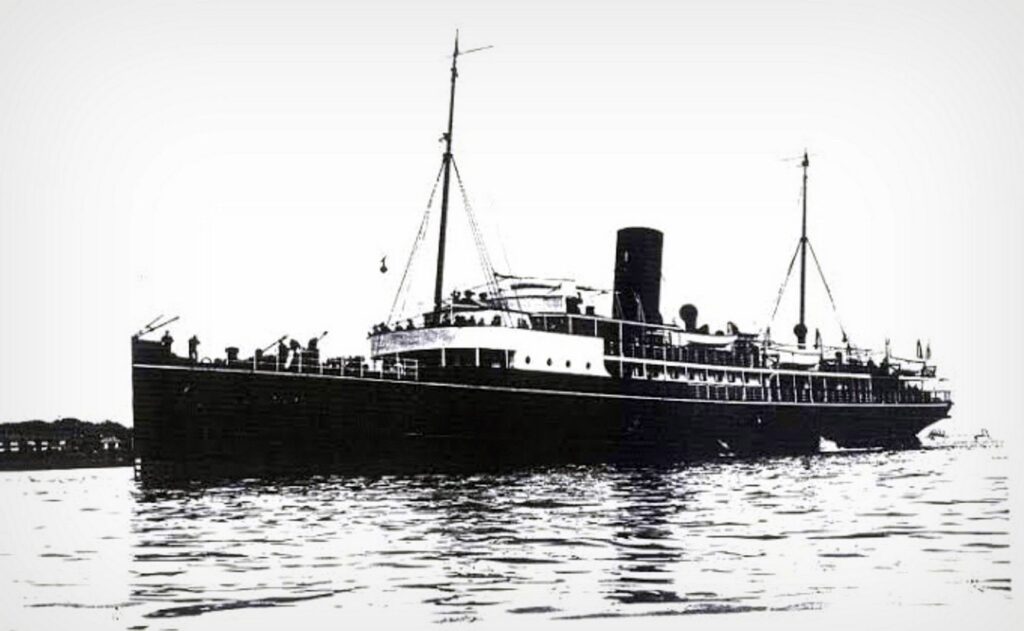
HMS Sarnia, another ferry steamer, was bigger than Hythe at 1,498 tons and had a top speed of 20 knots. Having already landed her cargo and troops she was leaving the peninsula, steering on course S67°W as Hythe headed N82°E – near head-on.
The troops had been preparing to disembark when the warning went out, and both ships were travelling at around 12 knots. Several attempts were made on both to change course – but neither slowed down.
Sarnia struck Hythe 8m from the bow on her port side, so forcibly that her bows cut halfway into Hythe, stopping her dead in the water. Her foremast fell onto the awning and many died in those first moments, as Hythe swung round by the stern and water rushed into the gaping hole in her port side.
She sank in 10 minutes flat. Some of those on deck managed to step aboard Sarnia, which remained alongside for several minutes. Others leapt into the cold sea without life-jackets and only debris to cling to – few of the soldiers was able to swim.
Captain Salomons was reported to have handed his own life-jacket to another soldier as Lt-Cdr Bird ordered: “Every man for himself!”
No co-ordinated attempt appears to have been made to organise a rescue, but a boat manned by a midshipman and a cook did pick up 82 survivors. Although also holed, Sarnia put out a boat and saved lives. She had to return to port stern-first to avoid taking on water.
Captain Salomons and a further 128 members of 1/3rd Company were lost along with 15 other Army personnel and 11 of Hythe’s crew. Only 103 members of the 1/3rd survived.
The disaster was compounded by the lack of life-jackets and emergency lifeboats, combined with poor organisation. It could have been avoided had the ships followed the set inward and outward routes to and from Cape Helles. A court of inquiry would later recommend that no soldier should ever again go to sea without a life-jacket.
Finding the wreck
In the last chapter of my book Echoes Of The Deep, Wrecks Of The Dardanelles Campaign, I had concluded that beside all the wrecks covered in the book there was still work to be done to locate a few more major wrecks from the campaign.
I wrote that back in 2013. Since then I have located and identified some more, including the British minesweeper Duchess of Richmond lying at a depth of 84m (as reported on Divernet).
After that I concentrated on HMS Hythe, one of the only two wrecks left unlocated. I knew from the archives that she had left the British naval base at Mudros Bay at 4pm and four hours later had some 40 minutes left to reach her destination. Using this information I was able to determine a search area of 9sq miles around six nautical miles west of Cape Helles.

This is quite a windy area, so it took me a few months to carry out the sidescan sonar search whenever the weather conditions were favourable.
On 19 August this year I spotted a wreck on the screen some 6.5 nautical miles west of Cape Helles, sitting upright on the seabed at a depth of 72m. It appeared to have the correct dimensions and shape to be the Hythe.

To see and film the important details required to identify the wreck, we completed the formalities with the Gallipoli Peninsula Historical National Park Directorate and Dardanelles Coast Guard and organised an exploratory dive.
We would use rEvo closed-circuit rebreathers with an 18/45 mix, together with 18/45 and nitrox 50 mixes as bail-out gases. Planned total dive-time was 68 minutes, with a bottom-time of 19 minutes.
The dive
27 August was a very nice day, with calm seas. I placed the boat above the wreck’s location and dropped the shotline.
Fellow-divers Ali Ethem Keskin and Doruk Dundar made the preparations for filming the wreck. We planned our dive-tour based on the information I had gathered from the documents about the sinking.
Visibility was around 15m, but reduced to 4-5m on the wreck.The shotline had landed exactly at its centre, just behind the point where the funnel had once been. Beside this point were the davits on both sides where the two life-boats were placed.

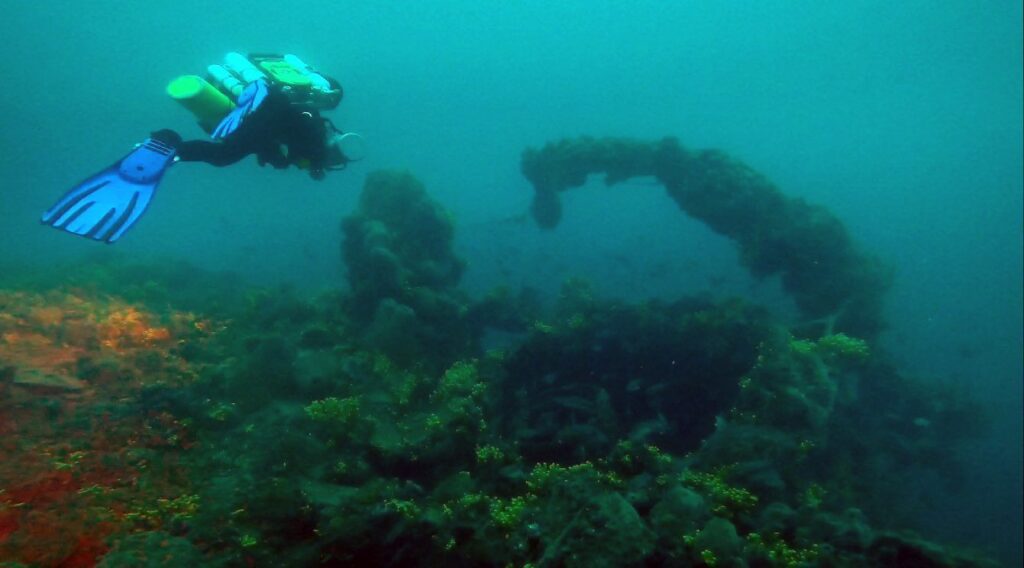
Further back, where the superstructure ended, the big davit/crane could be seen on the port side. The damage at the stern had probably been caused when the ship hit the seabed stern-first and/or when Hythe had swung around and hit Sarnia. A large deformation on the port side of the superstructure could be further proof that this was what had happened.
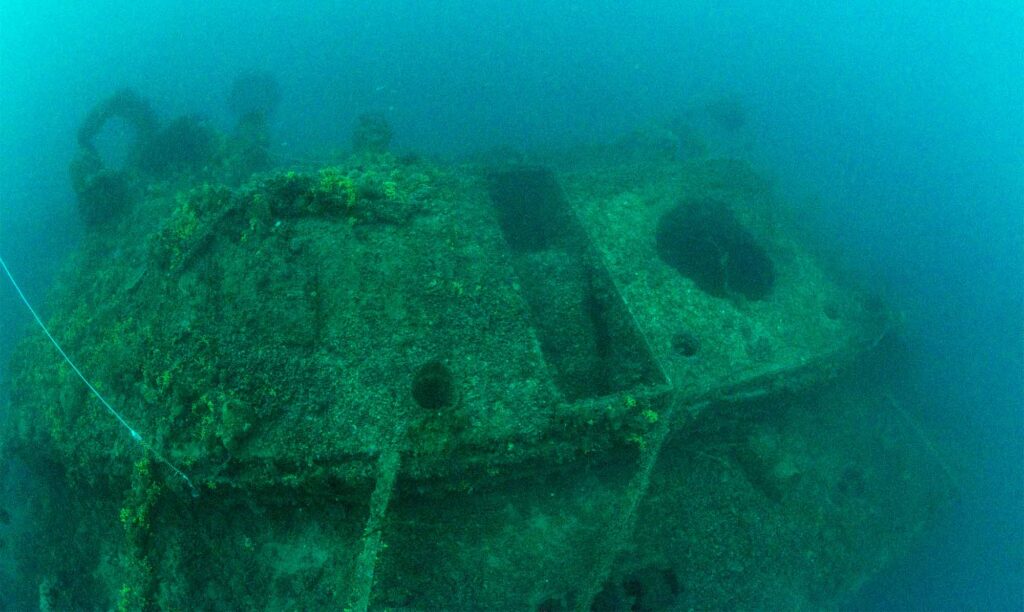
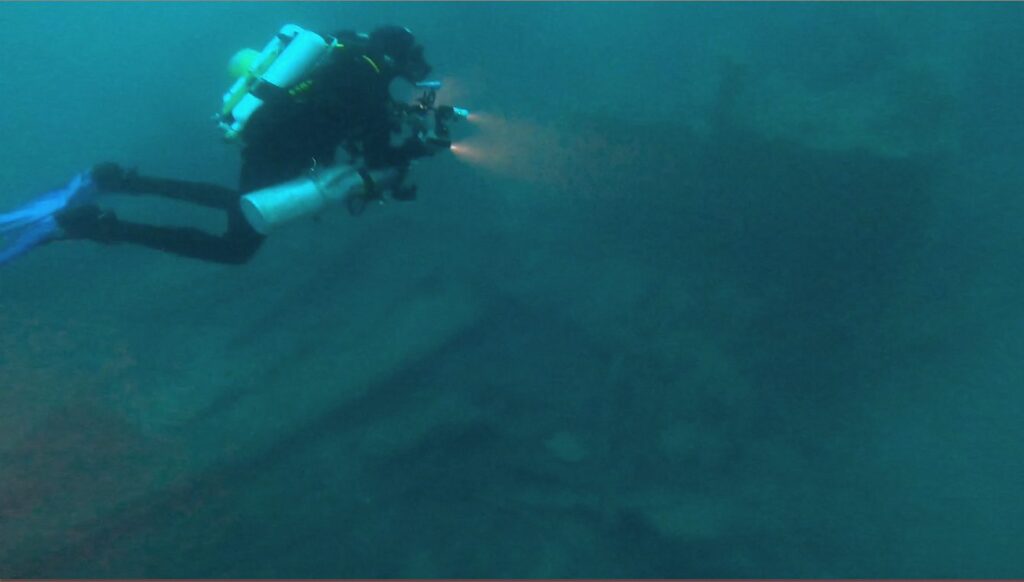
In front of the funnel, the remains of the bridge/wheelhouse, probably a timber structure, could be seen. The sight of the foredeck with the foremast lying on it confirmed the whole story – Sarnia had not only penetrated the port side of the hull just behind the forecastle but had gone through the whole beam, ripping out the starboard-side of the hull as well.
This much bigger vessel had rammed Hythe at speed, and we wondered how the smaller ship had been left in one piece at all, and with the bow still attached.
This discovery leaves HMS Arno as the only major Dardanelles campaign shipwreck left to be located. It must lie somewhere north-east of Imbros Island at a depth exceeding 300m, so we will need to use different technologies to locate and identify that one.
Aftermath of Hythe’s sinking
It is hard to imagine the effect that the Hythe disaster had on the people of Kent. Several pairs of brothers were lost. A father and son drowned together, and some 99 children were left fatherless.
After further research, I discovered that Sapper Edser had been one of those aboard Hythe – and that he had survived the sinking. Another surviving sapper, Reginald Still, had written in a letter home: “Reg Edser is quite safe, in fact he is with me now, writing.”
The company had some rest and leave, then continued to Gallipoli. On 24 November, two sappers injured by a bomb thrown by the Turks were removed to hospital in Egypt, and one of them was Edser. He wrote to tell his mother that his wounds were not serious, but he died in hospital on 14 December.
Meanwhile the Salomons family had lost their only male heir. In WW2 a mobile canteen serving troops in North Africa bore on its side “David R Salomons 1885-1915”, an inscription paid for by his sister Vera.
Between the wars, the people of Southborough would hold a “Hythe Sunday”, remembering the disaster in church services on or near to 28 October. It is not known when this act of remembrance ended. Several street names in Southborough still have a “Hythe” theme.
A marble memorial plaque to commemorate the lost soldiers can be seen in St Matthew’s Church in Tunbridge Wells. There is also a David Salomons House, named by his sister in memory of the company’s popular captain, and a Salomons Museum dedicated to the three Davids – the captain, his father and his grandfather, who in 1835 had become the first Jewish Lord Mayor of London.
There is a letter in the museum, written to Col Sir David Lionel Salomons by Hythe survivor Major Alfred Ruston: “At the beginning, the two vessels clung to each other for a few minutes and about 50 men and several officers scrambled across onto the other vessel,” he wrote.
“But though Captain Salomons was warned to get over also himself, he would not do so and I am sure that it was because he would see his beloved men off first.”
Also on Divernet; Kolay Finds British Minesweeper At 82m, Lost Ships Of The Battle Of Oinousses, Nantaise Days, How I Found 125-Year-Old Oil Tanker Still Leaking, Kolay Discovers WW2 British Sub In Aegean
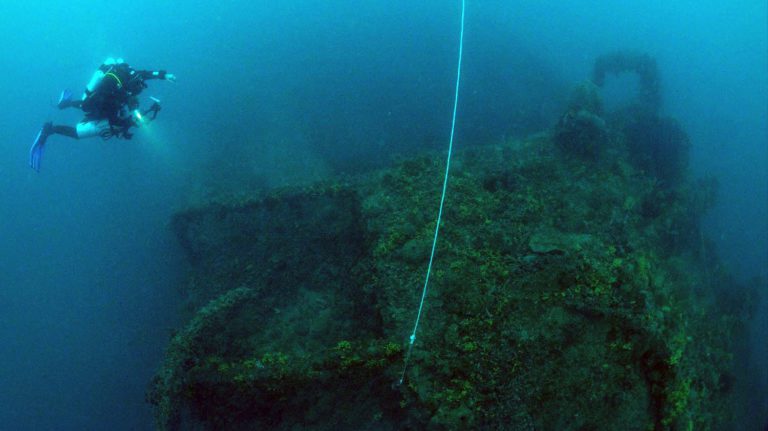

Absolutely thrilled that at long last we have closure on Grandad Wakefords resting place. What an absolute champion you are. Would love copies of any material about this as I live in Australia and we don’t have access to your magazine. With thanks.
Diver no longer produces a magazine, everything is online. We recommend Scuba Diver ANZ, which is an Australian-based magazine our sister brand produces.
WILLIAM HENRY SALTER Service number 916 Age 20 born 1895 from 11 Stuart Rd Tunbridge Wells, Kent, 2nd Corporal Royal Engineers 1/3rd Kent Field Company Southborough, Kent. My granfathers brother. I am a diver myself living in Malta. Thank you for this information it is much appreciated. There are many who lost their lives in those waters, my hope is that these War graves are treated with the utmost of respect as they so fittingly deserve. RIP
The photograph of HYTHE in the post is that of the ship built in 1925 for the Southern Railway to replace the ship lost off Cape Helles in 1915. Though similar in design the two HYTHE’s did have many differences in appearance, dimensions and tonnage some of which can be seen in the attached photo of the 1905 HYTHE on builder’s trials off Dumbarton
Thank you for pointing this out, Tony